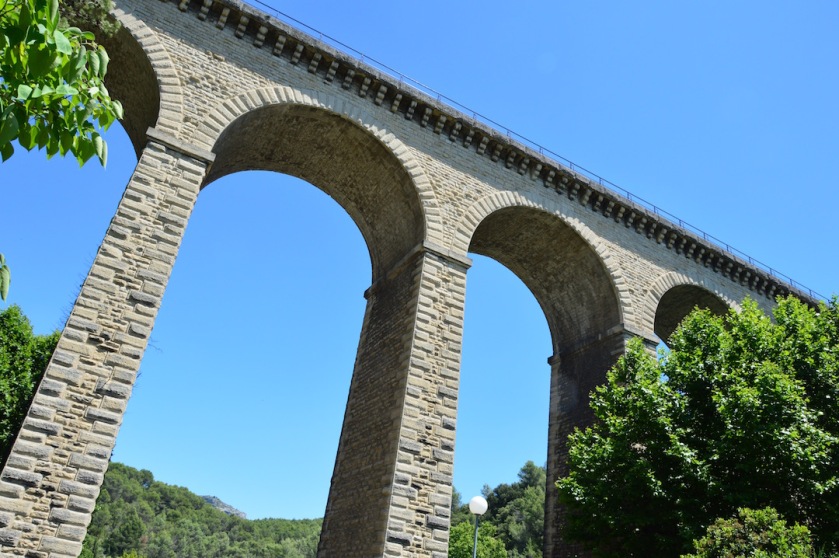
We fall asleep and wake up to the sound of rushing water.
We’re installed in a former mill, now the Hôtel du Poète, in the ancient village of Fontaine de Vaucluse. Water gushes everywhere, braids into a hundred channels, leaps over stones and dashes along walls and buildings, disappearing beneath and then bursting out again on the other side. Massive water wheels, which once powered the mills, are now decorative but still turn, covered with inches of dripping moss. Ancient millstones lean against buildings, and everywhere giant plane and fig trees, iridescent damselflies and trout hovering sleepily in the watery turbulence.
And yet, blind to all this, driving here from Avignon, wedged into the middle seat of our transport van, I anxiously scoured the roadside looking for the shoulder where I was expecting to run. There are no shoulders. Just rocks and dry, waist-high shrubs pushed up against the asphalt, trucks and cars hurtling by, and no place for a poor runner to go.

I wonder how much trouble it will be to transport my body home. Easier and cheaper for all concerned if they just bury me here. Cremation has always seemed the more sensible and environmentally correct option, but on the other hand, the local cemetery must be quite picturesque. Friends could combine a nice holiday in the South of France with a visit to my grave. Maybe shed a tear or tear or two, voice a few regrets (I never told him how much I loved and respected him. And now it’s too late…), raise a glass to my memory.
But if I’m serious about interring my bones here, I should at least tell someone of my intentions. I should write it on a Pastis coaster and leave it where it can be easily found. Then I thought of other objections. Such as the fact that I’ve been baptized Greek Orthodox and the local clergy, increasingly jealous and territorial, might…
“How far eet eez you want to run, monsieur,” inquired the man at the desk.
It was a couple of hours later and I was kitted out for running. I told him.
“Ah,” he said, pondering. He instructed me to return the way I had arrived. In about one kilometre, I will see an aqueduct. Look for a path on the right, and run along the water. No cars. “Bon chance!”

The ass
It took a couple of tries to find the path. I passed a kayak rental place swarming with school kids in life vests, then labouring, unhappy-looking cyclists in spandex, then carloads of Italians shouting at each other.
As I turned a corner, there it was. Monstrously large, clambering down on giant stone legs from the mountains and striding across this narrow valley to descend on the other side and water the grapevines and figs. In my white-knuckle anxiety about where to run, I had missed it when the van passed right beneath.
It took a couple of tries but I finally found the path and climbed to the top. A grey-green channel flowed silently from the foothills, almost funereal in its progress, compared to the mad watery scramble below.
In a moment, I was running along a cool tunnel of vegetation, dotted with wild poppies and daisies. Further along were olive and fig trees, clumps of bamboo and oleander. Mother ducks and ducklings slipped into the water ahead of me, alarmed by the clomping human. At this point, when I thought it was all too much, somewhere close by a donkey began to bray and I had to laugh at my luck.

French engineering
“Probably a Roman aqueduct,” I said later on at dinner, over roast duck. After all, we’d just visited some very extensive Roman ruins in Lyon, which is 250 kilometres north of here, via the TGV. It stands to reason that the Romans would have begun their pillaging and rebuilding here first.
But then I looked it up and this aqueduct is as French as brie.
It was built in the mid-nineteenth century to bring irrigation water from the Canal de Carpentras, which begins in the foothills of the Alps, to the Comtat plain, before emptying into the Ouvèze River.
So far, I’ve run three times along the aqueduct: a let’s-see-what-this-is-like run, a tempo run, and intervals.
Which reminds me, I have no idea how deep the aqueduct is and I know for a fact that Spyro is capable of drowning in a saucer of water. I should check on a map to see where it actually leads, and the possibility that my waterlogged body could wind up wedged beneath a grapevine. Not a bad way to go, all things considered.

I love you maaaaaan. Enjoy all the good things the South of France has to offer.
LikeLike
Thank you Karim. Of course, thinking of you all the time.
LikeLike
Spyro I’m so happy you managed to find somewhere to run! Where there’s a will…..and you certainly are not lacking will. What a beautiful area with sights and sounds to soothe the soul.
LikeLike
Thanks, Orit!
LikeLike
Lucky you! To be there, in France, and at a hotel with the best name possible, especialyy for a poet…If I ever get to France, I’ll look for it. Thanks for telling about your running there…
LikeLike
Yes, lucky me. As I noted, I’ll be getting back to the poet lickety split.
LikeLike
A wonderful place! Water…life and death.
LikeLike
Thanks for putting it all into universal and sad perspective, Isobel. You’re someone after my own heart.
LikeLike
Superb! Your travelogue writing is always a delight. Terrific photos! I look forward to the next instalment.
LikeLike
Glad you enjoyed it, Alison. Another is already out there…somewhere.
LikeLike